
by Scott Schrage | University Communication and Marketing
It epitomizes the Great Plains in spirit and in form: a 2,000-pound tank on hooves, cloaked in shaggy winter-tested coat, capped by horns acting as warning and weapon.
Even its scientific name, Bison bison bison, seems to conjure an echo worthy of its majesty. Still, the implacable profile of the Plains bison — the national mammal of the United States and largest on the continent — belies the vulnerability in its history, which saw its legions decimated from tens of millions to just a few hundred in the span of a few colonial centuries.
Conservation efforts have pushed its number back to roughly 20,000, and its status from endangered to near-threatened. But a recent study led by the University of Nebraska–Lincoln’s Nic McMillan hints that the ongoing conservation of the Plains bison will demand accounting for the climate — especially the number of scorching days and powdery landscapes — it encounters moving forward.
McMillan and colleagues at Oklahoma State University have found GPS-backed evidence that temperature and extreme drought can drive movement among herds of Plains bison. Continued increases in both, combined with the fact that most bison herds are now confined to fractions of the land they once roamed, could pose challenges to managing the iconic species, McMillan said.
“When we think about reintroducing bison or any large animal to a landscape, the landscape that the animal is inhabiting is potentially a lot smaller than it was historically,” said McMillan, assistant professor of agronomy and horticulture at Nebraska. “In 1491, if there was a drought in northeastern Montana, the bison had the entire Great Plains to escape that drought. They could move as far as they needed to.
“In this time when we’re seeing more extremes — more of those extreme air temperatures, more of those extreme droughts — we probably need to rethink how these landscapes are structured, and whether or not they’re actually meeting the fundamental physiological needs of these animals.”
Continue reading the full story at Nebraska Today.
More details at: https://go.unl.edu/89ru